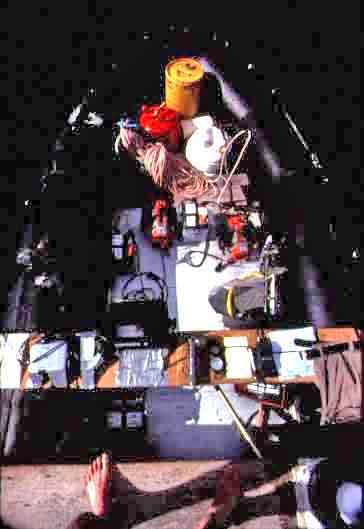Recollections of the Past 30 years pursuing Coelacanths
Jerome Hamlin, creator dinofish.com
Luckily with outboard motor boats, I was very familiar, something like Brer Rabbit in the briar patch. I knew the tricks. I faced the bow out towards the sea so it would take the oncoming waves head on, rather than have them swamp us over the transom. We had to stay in motion or there would be no control of the boat. So we would head out to see for about thirty seconds, then to avoid getting lost in the storm in that direction, I’d throw the engine into reverse and back in toward the breaking edge of the waves. Back and forth. This went on for about an hour. Then just when our fuel was running low, we saw we had drifted towards the mouth of an inlet with no obstructing lava formations. We could see Mombasa and others on the shore waving us in. I kept the bow pointed seawards and reversed into the inlet. This confused those on shore and they waved frantically trying to tell us to turn around! We made it in without being swamped. Soaking, but relieved to be alive and uninjured, we were driven to the home of the Governor of Grand Comoro. His grandchildren were watching Aliens from a VCR in another room. "Faites attention a la mere!" he cautioned.

Zodiak Cage search at night. The sonar is ahead of my left foot. It ran off a small car battery. Notice a small compass and radio on the shelf next to it. Lines for the grappling hook are in the bow. The radio was to alert Mombassa when we were coming back, so we would not be mistaken for comandos and be fired at from the shore battery at Itsandra
It was a great disappointment not finding that cage, and speculation simmered that the fish had been stolen. One thing had become clear, the coelacanths could not be targeted for catching. Our presence there, with all the coastal villages knowing we were seeking a live fish, produced nothing. The two catches on our frst visit in 1986 must have been flukes. Furthermore, our active fishing by our own team had no advantage over local fisherman, because the sonar had not proved effective at the 700ft depths. Only a passive intercept of random bycathces, held out any hope. Before we left the Comoros on this visit, we arranged for a new decompression cage to be delivered to the Japanese fishing school on the nearby island of Anjouan. Perhaps they would have better luck.
Back in New York, the bottom fell out. When the German submersible team had visited the Comoros after our fall '86 expedition, they were joined by Michael Bruton, then director of the JLB Smith Institute in Grahamstown, South Africa, and visiting professor Eugen Balon of the icthyology department of the University of Guelph in Ontario, Canada. At a breakfast get together in Moroni, the visitors met with Hans Fricke and French oceanographer, Raphael Plante of the Jago submersible team. The four decided to set up and direct a Coelacanth Conservation Council (C.C.C) that would control coelacanth research henceforth. Now, their group had got wind of the fishing promo ad in International Angler magazine that had designed as part of the original plan to solicit fishing teams to keep our project going for several months until successful. They used this to attack my project and the Explorers Club, and by proxy New York Aquarium, as exploiting the rare fish for sport fishing! And this controversy was playing out not by the lava shores of the Comoros, but in the pages of the New York Times!
